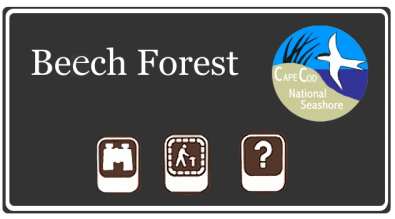
Dear Bird Folks:
Every day for the past few months, I’ve been taking a peaceful early morning walk through the National Seashore’s Beech Forest in Provincetown. Except for the occasional odd character, the Beech Forest has been totally quiet and placid. That all came to an end last week when dozens of freaky bird watchers arrived one morning and continued to be there every morning after that. Why are they suddenly there and when will they leave?
-Sadie, N. Truro
Well Sadie,
It seems like someone has some problems with sharing. I like privacy now and then too, but if you want privacy you can’t expect to find it in a public park. It’s funny how often we run into the public in public areas. Although I agree with you on one thing, bird watchers are freaky.
What you have run into Sadie is called spring migration. Spring migration is like a fireworks show, starting slowly in March, building in April and ending with a grand finale in May. The main feature of the grand finale is the tiny chickadee-sized birds called wood warblers. Warblers aren’t quite as loud as fire crackers, but they are every bit as colorful. With colors ranging from bright blue to orange and yellow, the warblers are some of our most handsome birds. Even a nonfreak like you might enjoy seeing a warbler.
What makes the warblers so special is that many of them are only in this area for a few short days each year. Most warblers spend the winter in the distant tropics, living among the monkeys and the drug lords. Each spring thousands of these tiny birds come pouring out of South America, island hopping across the Caribbean or flying nonstop across the Gulf of Mexico, to reach the deep forests of North America.
Warblers, like most songbirds, eat during the day. Day time feeding forces them to take on the challenges of night time migration. These little birds must fly great distances in the pitch black in order to have time during the day to feed and rest. Night time migration produces some amazing mornings for bird watchers. I’ve spent hours walking through the Beech Forest without seeing a single bird, only to visit the next day to find birds everywhere. Where did all the birds come from? The night time winds have pushed a wave of migrating birds over Cape Cod.
With all the good feeding habitat on Cape Cod, why would the warblers choose the Beech Forest? The Beech Forest is sometimes called a “migrant trap”. It’s like the last rest area on the turnpike. Birds that are pushed along the shore by the winds, stop to rest and refuel before taking off across the long open expanse of the Atlantic Ocean towards northern New England.
The Beech Forest, with its fresh water ponds and diverse habitat is an oasis amongst the sand dunes of the Cape tip. It is this diverse habitat that attracts the migrating birds, and the occasional odd character. And, because the Beech Forest is such a small area, the “trapped” warblers are able to be seen by the freaky bird watchers. Some years, most of the roughly forty species of warblers that pass through the eastern U. S. in the spring can be seen in the Beech Forest. In addition to the warblers, tanagers, grosbeaks, buntings and thrushes can also be seen in there.
So to answer your question Sadie, as unusual as this may sound, the bird watchers that you are seeing are watching birds. But don’t worry, they won’t be there long. By June the migration will be over, the birders will be gone and you will be alone in the Beech Forest once again. Well, you’ll be alone if you don’t mind the arriving summer tourists, the swarming mosquitoes and the occasional odd character.